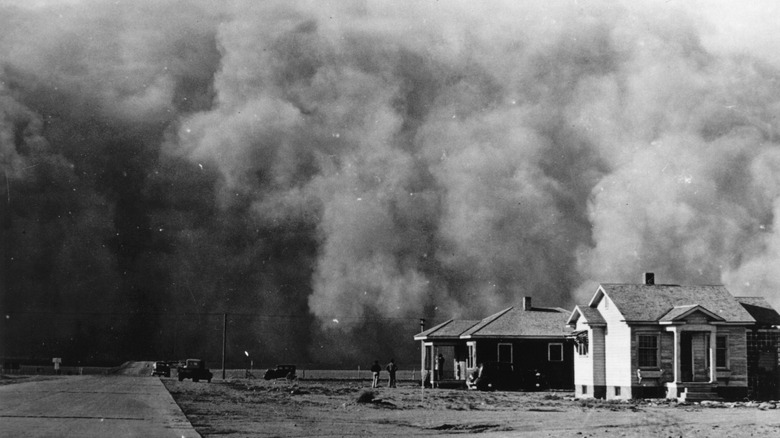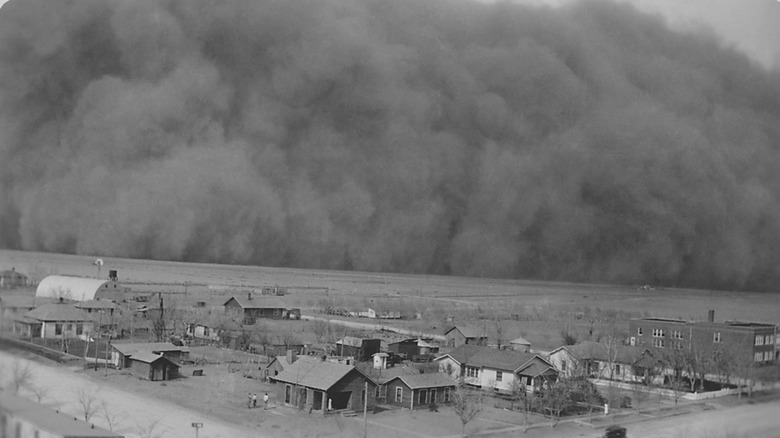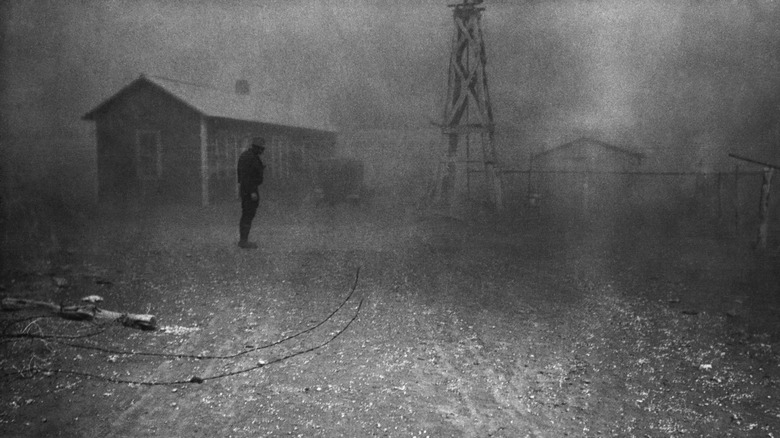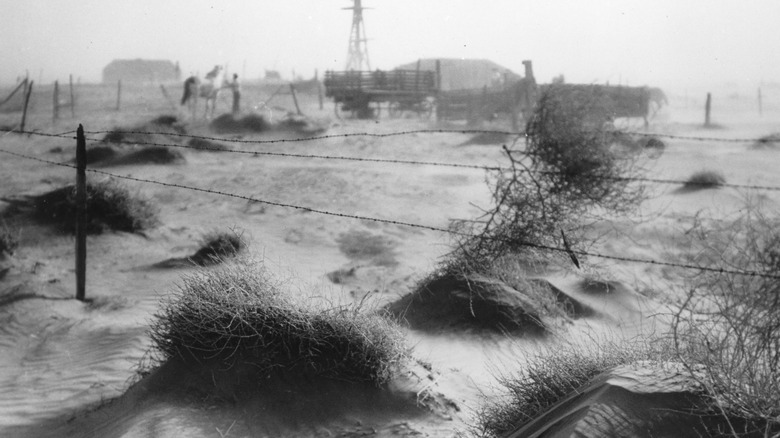The Truth About Black Sunday In The 1930s
The 1930s were a tough time for America. At the peak of the Great Depression, 15 million Americans were out of work, and many were struggling to support their families and put food on the table, per Love to Know. And while the streets of big cities were teeming with out-of-work people looking for employment, life in rural America wasn't much better. Although some Americans were able to squeak by growing their own gardens and making their own clothes, residents on the southern Great Plains, particularly in eastern Colorado, western Kansas, northeastern New Mexico, and the Oklahoma and Texas panhandles, were struck by a massive drought, which created some of the worst agricultural conditions in the country and forced them to contend with some of the most severe weather events in American history (via Encyclopedia).
Farmers who moved to these regions following World War I did enjoy almost two decades of excellent harvests. However, they also overfarmed and employed techniques, which stripped the land of the native grasses that helped protect and hold the topsoil, according to History. So in the 1930s, when a bad drought hit the plains, their wheat crops couldn't grow, the topsoil was depleted and dehydrated, and people became desperate for rain.
Agricultural practices worsened conditions on the Great Plains
A bad harvest wasn't the only problem they had to face. With no crops to protect and anchor the topsoil, wind storms on the plains blew loosened soil and dirt into the air, creating massive dust storms. These storms, called "black blizzards" or "dusters," could sometimes reach speeds of up to 40 miles per hour, per the National Weather Service. They blew swirls of dust and dirt across the plains, darkening the land until it looked like night and forcing people, coughing and choking, to seek shelter from the storms. Record high temperatures throughout the summer of 1935, which often topped 100 degrees Fahrenheit, only worsened matters, according to Encyclopedia.
The dust storms were both a cause and an effect of the eroded agricultural landscape. The exposed topsoil was easily picked up by the strong winds, and the more topsoil was disrupted, the worse the quality of the land became, creating a grim ongoing cycle of severe dust storms. And even while the conditions continued to worsen, farmers continued to plow and sow their field, which only further depleted the topsoil. "Farmers were still trying to plant a crop and in many respects making it worse," said R. Douglas Hurt, head of the history department at Purdue University, told History.
Black Sunday was the most severe dust storm in history
On April 14, 1935, the worst dust storm in American history blew into the Great Plains, following a period of brief reprieve when some residents thought the worst was finally over. That morning, the skies had cleared, the sun came out, and the winds died down for the first time in months. Feeling cautiously optimistic that the conditions might be improving, people emerged from their homes to work outside or enjoy the sunshine. However, the good weather was unfortunately short-lived.
Within hours, the temperature dropped over 30 degrees, and the winds picked back up again with tremendous force, whipping up a wall of black sand and dust over the entire region that reached thousands of feet high in the air and was hundreds of miles wide, per History. The dust cloud was so thick that it completely blocked out the sun, creating conditions that were "so dark that you couldn't see your hand before your face, you couldn't see anybody in the room," one resident recalled. The massive storm lasted for hours, blowing across 1,000 miles of land and displacing around 300,000 tons of topsoil, per Smithsonian Magazine. While no deaths were reported, many experienced respiratory issues, and at least one man lost his sight, according to History. In the midst of the storm, some people were sure the end of the world had come. That fateful day was termed Black Sunday.
The government incentivized different agricultural practices after Black Sunday
"Three little words achingly familiar on a Western farmer's tongue, rule life in the dust bowl of the continent — 'if it rains,”" Associated Press reporter Robert Geiger famously began his account of Black Sunday, which was filed with the Washington Evening Star in the aftermath of the storm, via Smithsonian Magazine. Following the terrible events of the Black Sunday storm, the U.S. government decided it was finally time to act. Congress passed the Soil Conservation Act, stating that "the wastage of soil and moisture resources on farm, grazing, and forest lands ... is a menace to the national welfare," according to USDA. The new law established the Soil Conservation Service and provided incentives for farmers to put into place more sustainable agricultural practices, which would help prevent such damaging conditions from developing in the future. The government also paid farmers who owned the most marginal lands to stop producing crops on their farms and allow the land time to heal. These new agricultural practices improved topsoil conditions greatly, but not before almost one-third of Great Plains farmers abandoned the area. The Great Plains region has never again experienced such intense dust storms, but this era serves as a chilling reminder of what can go wrong if we do not take care of the earth.



